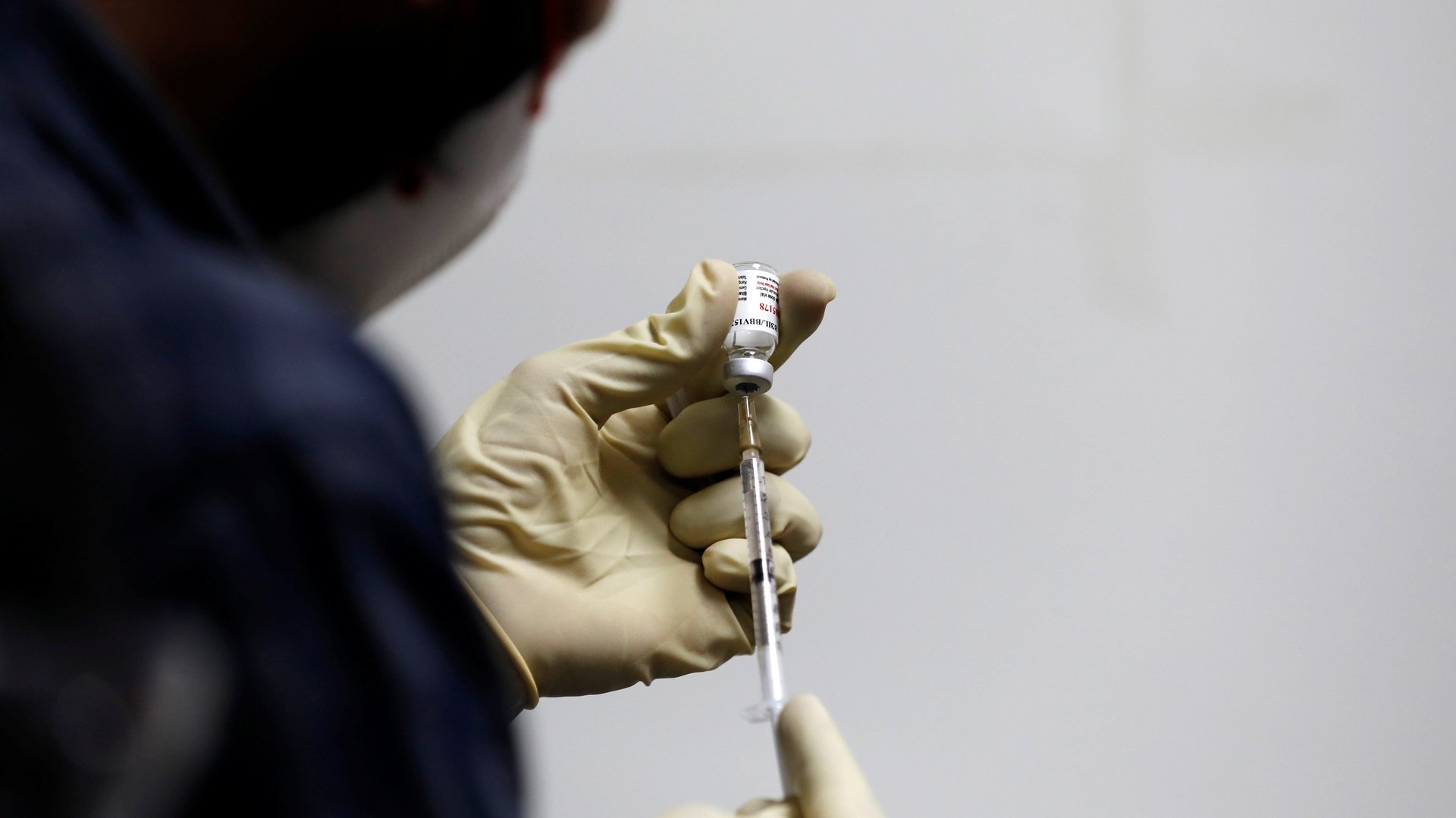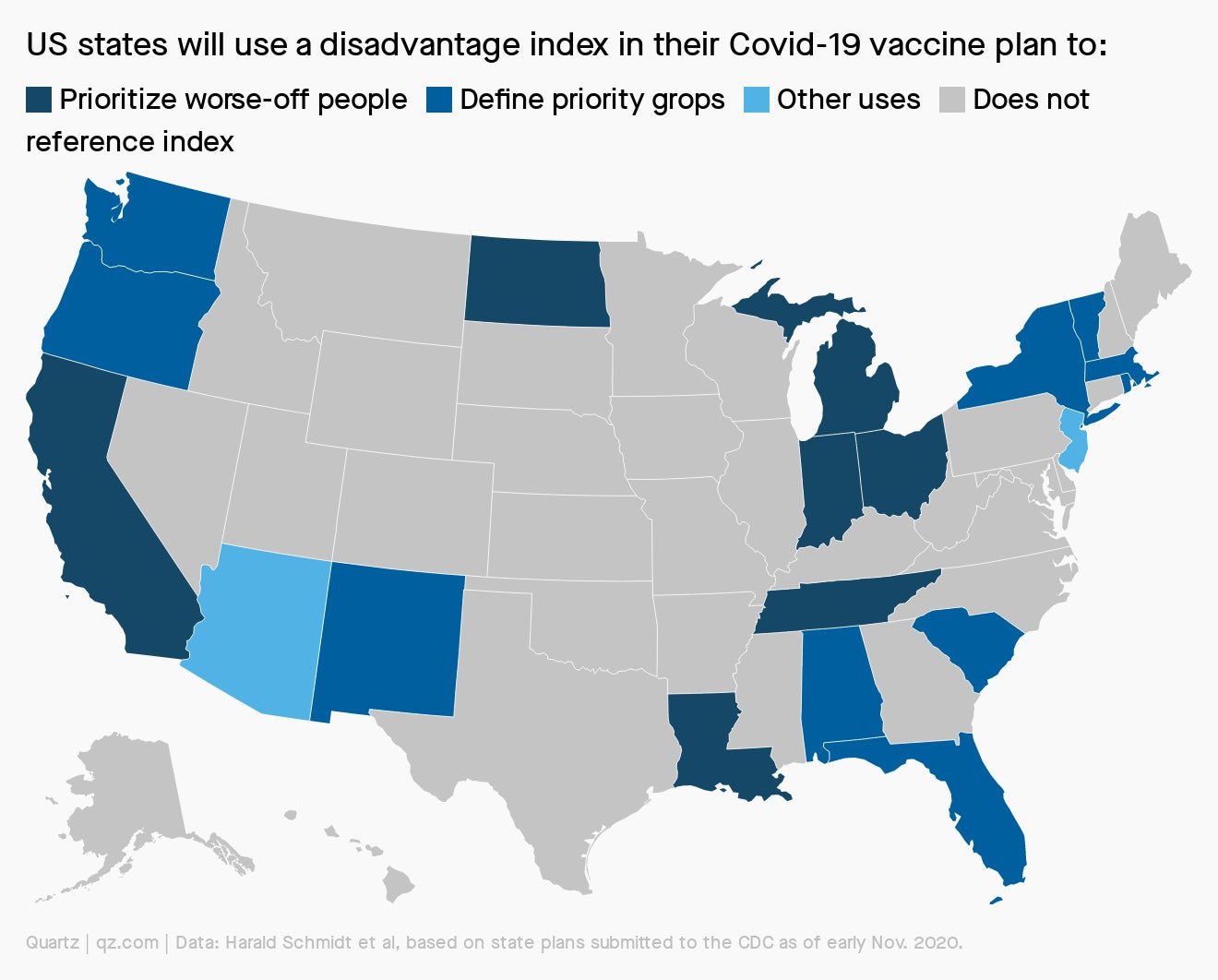The gift of jab
Hello Quartz readers,


Hello Quartz readers,
The US started administering Pfizer’s Covid-19 vaccine to healthcare workers this week, and while there are federal recommendations about who should be first in line, exactly which arms get jabbed first is up to the individual states. At least 19 of them are considering measures of inequality, including poverty and race, in order to reach those who are worse off.
It’s an unconventional approach. Vaccine campaign managers have typically paid more attention to the number of lives they can save than the demographic details of those lives. But Covid-19’s outsized effect on people of color is injecting an element of social justice into vaccine allocation. A variety of experts, from the World Health Organization to the US’s National Academies of Sciences, Engineering, and Medicine, are suggesting reducing inequality should be a goal of Covid-19 vaccination regimes.
“We can’t just continue with the same framework that simply seeks to maximize benefits, because that will very likely mean that minorities are not given the attention they need,” says Harald Schmidt, a medical ethics expert at University of Pennsylvania who analyzed the states’ plans. “They’ve been hit much harder.”
Many people of color would get priority under some of the categories the Centers for Disease Control and Prevention (CDC) has outlined: for example, people with two or more health conditions that increase their likelihood of getting sick from Covid-19. Some states will also use measures like the CDC’s Social Vulnerability Index, which in addition to poverty and race considers factors like car ownership, crowded living situations, and even English proficiency to rank a community’s degree of need in case of a disaster. Seven states will use the index to give disadvantaged people spots further up the queue.

Regardless of how they use the index, states might find they first have to prove their good intentions to the people they want to help. Given the US’s ugly history of race-based medical experiments, people of color have reason to be suspicious.
Broken record
The US continues to lead the world in daily Covid-19 deaths: On Dec. 9, the country lost more than 3,000 lives in a single day, surpassing the death toll of 9/11.
It can be hard for that number to sink in: Most people in the US still haven’t experienced a Covid-19 death firsthand. But that’s changing. Last week, a full third of US counties reported their highest-ever daily death toll from Covid-19. As the pandemic reaches every nook and cranny of the nation, Americans everywhere are experiencing loss.

Shots fired
“Indonesia should thank us Chinese people, even we are yet to be vaccinated.” —A Weibo user in China
Indonesia has been one of the most important overseas testing grounds for China’s coronavirus vaccines: Earlier this month, the country received 1.2 million vaccine doses from Chinese pharmaceutical firm Sinovac. But China’s efforts to use its vaccine program for “global public good” sometimes face criticism at home, from citizens who say the country is spending overseas at the expense of its own people.
Working it out
5.4%: EU employees who usually worked from home in 2019
15%: EU employees who had ever worked from home in 2019
35%: EU employees who now work exclusively from home
Feierabend: A German word for the time when work ends and leisure or rest time begins
As the pandemic makes remote work routine in Europe, an “always-on” culture is taking hold of people’s lives and bringing a debate over the “right to disconnect” to the forefront of local politics. Annabelle Timsit looks at whether Europe can effectively legislate the right to work-life balance, part of our field guide to the rise of employee activists.
We’re still searching for a German word to describe the joys of a Quartz membership, but the English term is “Yayyyy!” Not a member yet? Give us a try for seven days, free.
Track and field
Deploying the Pfizer vaccine—including delivering two jabs, weeks apart—is an enormous logistical challenge. To pull it off, the US is planning on connecting 61 separate vaccine registries with a new Amazon Web Services-mounted registry called IZ Gateway. But it’s not a cure-all: Some people may be excluded from this kind of system, including undocumented immigrants or people experiencing homelessness.
“Regardless of how well IZ Gateway works as an exchange medium, it’s not going to solve any of the underlying healthcare disparities that we already have,” says Diane Korngiebel, a bioethicist and research scholar at the Hastings Center. Katherine Ellen Foley looks at the US’s complex plans to keep tabs on Covid jabs.
You asked
The Pfizer and Moderna vaccines are made from mRNA. Does that mean they’ll mess with my genetic material?
Vaccines based on genetic material may give you pause. But mRNA vaccines, which have been in the works for nearly three decades, never touch our DNA, and as a result can’t interfere with human genes. Instead, they just borrow some of our cellular tools before harmlessly breaking down in a matter of hours.
Specifically, mRNA vaccines for Covid-19 take advantage of our cells’ protein-making factories, called ribosomes. Normally, our ribosomes create proteins based on recipes from our own DNA, which is locked up inside the nucleus, a protective, membrane-covered bubble within our cells.
The shot delivers a microscopic, fatty package into our cells, carrying a recipe—the mRNA sequence—for a protein that mimics the SARS-CoV-2 virus. When that mRNA meets up with our ribosomes, our ribosome chefs interpret this new mRNA as if it were a recipe generated from our own DNA, but the DNA inside the cell’s nucleus remains untouched.
Essential reading
- The latest 🌏 figures: 73.2 million confirmed cases; 41.5 million classified as “recovered.”
- Quick Q: Why didn’t Trump buy more doses of Pfizer’s Covid-19 vaccine?
- Light ‘er up: Seriously, it’s time to get a ring light
- Warp speed 2.0: Has Covid-19 permanently altered the development timetable for other vaccines?
- Taking the plunge: Will there be enough syringes to deliver Covid-19 vaccines?
- Private security: India’s vaccine delivery app must avoid the government’s legacy of privacy issues
Our best wishes for a healthy day. Get in touch with us at [email protected], and live your best Quartz life by downloading our iOS app and becoming a member. Today’s newsletter was brought to you by Ana Campoy, Katherine Ellen Foley, Jane Li, Tripti Lahiri, Katie Palmer, and Kira Bindrim.